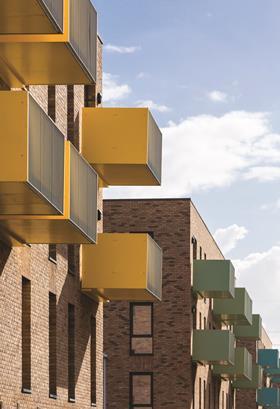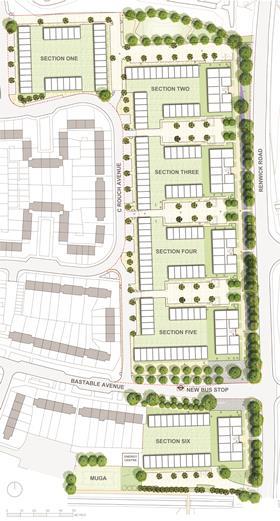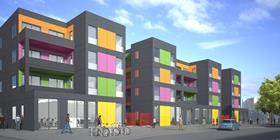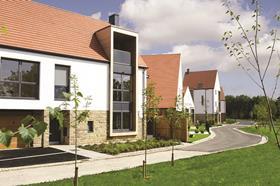After years of decline, council house building looks set to enjoy something of a resurgence. But can the new generation of council homes avoid the stigmas of the past?

In Britain today, the amount of homes directly owned and managed by local councils varies from just 10% to 14%. This is an enormous reduction from the average 50% of homes that were built and owned by local councils between 1950 and 1980, reaching a peak of
over 60% in 1975.
Of the 122,590 homes built in England in 2013, just 20% were social housing and a negligible constituent of this could be attributed to council housing. Even Britain’s chronic housing shortage doesn’t seem to have been enough to spark a new generation of council building. Until now.
For after decades of regression, the UK might just be on the verge of a major new council house building programme. It is no accident that many of the councils re-establishing themselves as strategic social housing providers are located in London where spiralling prices and constrained supply have led to an acute concentration of the housing crisis.
Newham council in east London has earmarked the construction of up to 20,000 new council homes. Southwark has committed to directly building 10,000 council homes over the next 30 years, while Ealing aims to build 500 by 2019.
Croydon, which is for now the most populous borough in the capital, has placed council house building at the centre of its £500m capital works programme. And Islington, historically one of England’s most pioneering council homes providers, plans to invest £1.5bn in building 2,900 council homes over the next 30 years.
The reasons for this resurgence are largely centred on recent changes to the tortuously convoluted funding mechanisms laid down to local authorities by central government. At its simplest, local authorities can now keep their rental income from their council houses (known as the Housing Revenue Account) and use it to self-finance building new housing stock - albeit with significant fiscal constraints. Previously, housing revenues were pooled nationally and taken by the Treasury.
But what is immediately interesting from an architectural point of view is not necessarily how this new generation of council homes are to be financed, but what they are going to look like. And even more importantly, what kind of surrounding urban environment they are going to sustain.


These questions are particularly important because for many, the legacy of the last tranche of public housing is still an overwhelming negative and pejorative one. Of course not all public housing from the 1960s and 1970s was a failure but many of its worst characteristics still loom large in the public consciousness. These include corrosive characteristics such as poor design, insufficient quality, excessive concrete, inhuman tower blocks, inadequate maintenance, high crime, economic exclusion and social deprivation.
It is essential that the new generation of council housing avoids these stigmas. Therefore the design characteristics that will define new council housing are of enormous social as well as architectural importance.
The best way to understand the new design agenda for contemporary council housing is to analyse some of those examples of new council housing that have already been built. As so much council housing stock from the 1960s and 1970s remains in place, particularly in the form of council estates, current council house interventions often take the form of smaller infill sites within existing estates.
Many of these infill sites are redundant garages or similar ancillary locations that have become havens for crime and anti-social behaviour and exhibit some of the worst aspects of former council estate design: poor lighting, minimal surveillance, dead ends, blank facade and no connectivity. They therefore provide a perfect test-bed to compare the new council house design characteristics with the old.
Pollard Thomas Edwards (PTE) Architects has a huge amount of experience designing new council housing and has worked on improving up to 40 housing estates. It is now working on up to 500 council house schemes that range from pre-planning to under-construction phases.
One of their projects, Bradwell Street in east London which is under construction, is a classic example of new housing being inserted into a forgotten infill site which is part of a larger estate. According to PTE partner Tricia Patel, it is often these formerly inhospitable infill sites, such as rows of garages, which “by being turned into mews courts with units that can perhaps utilise a quirkier plan, become some of the most popular and successful of the new house types created”.
Another completed PTE scheme, Thames View East in Barking, also in east London, is an example of an entirely new council housing development financed by a private equity investor but with the freehold retained by the local authority.
Both schemes feature many of the characteristics of contemporary council house design: simple geometries and envelope, brick facades, controlled material palette and rational, orthogonal plans. In their brightly coloured front doors and projecting entrance porches, both schemes also clearly celebrate the idea of “the street”, a concept rigorously suppressed in the anonymity of many of the seventies council house estates.
For PTE partner, Tricia Patel these and a selection of other key design characteristics define the architectural approach the practice commonly adopts when working on new council housing. “In many of the old housing estates you’ll often find a very strange relationship between fronts and backs of blocks with the backs perhaps facing onto an empty park and the fronts facing away from the street. This often led to many of the social and crime problems present on estates because there was no opportunity for surveillance which had a detrimental effect on safety. It’s fundamental that new housing has a clear, front-facing relationship with the street.”
Patel also cites public realm as a key concern. “Lack of open space was not necessarily the problem in older estates; it was the quality of that space which was poor. Reclaiming public realm via good design and improved connectivity is essential.”

With regards to housing, the very concept of an “estate” is a problematic one because it immediately suggests physical severance and social autonomy from the surrounding city which again erodes connectivity and inevitably leads to an insular, inward-looking urban environment. Again, this is a corrosive characteristic that Patel is keen to suppress.
“Connectivity is the key, ” she says. “Creating a network of new streets and routes that have a clear connection to the outside world. It’s about encouraging other people who don’t live on the estate to walk through. It’s about ‘de-estating’ the estate. People are familiar with the concept of tenure-blind housing. Well, in a sense what we want is tenure-blind streets where you can’t even tell that you’re passing through a new development.”
Much of the stigma of sixties and seventies public housing is associated with the perceived evils of tower blocks and deck access, aspects that featured largely on earlier council estates and which are often blamed for “de-humanising” their social and urban character. It’s a position that Patel strongly rejects. “The problem isn’t the building typology, whether it’s tall or low-rise. It’s always a question of applying good design and getting the layout and masterplan right.”

So what of the local authority perspective? What do they want to see delivered from a new generation of council house design? Bob Porter, head of communities at Shepway District council which has just completed 250 new council homes in Ashford, says: “Our priority is quality. Our role is to create a framework that delivers that quality through partnerships, strategic development and generating revenue and finance. There are challenges.
“We haven’t built council houses for 30 years and there’s a skills set that we need to replenish that includes architects, engineers, project managers. A lot of that expertise is now with housing associations but we’re keen not to undermine registered social landlords or go into direct competition with them and what they do.
“But there’s no doubt that it’s a really exciting time and there are huge opportunities out there. I never thought that I’d see the day when local authorities would be building council houses again and I for one am delighted.”

For more programme information and to register go to www.ecobuild.co.uk.




























No comments yet